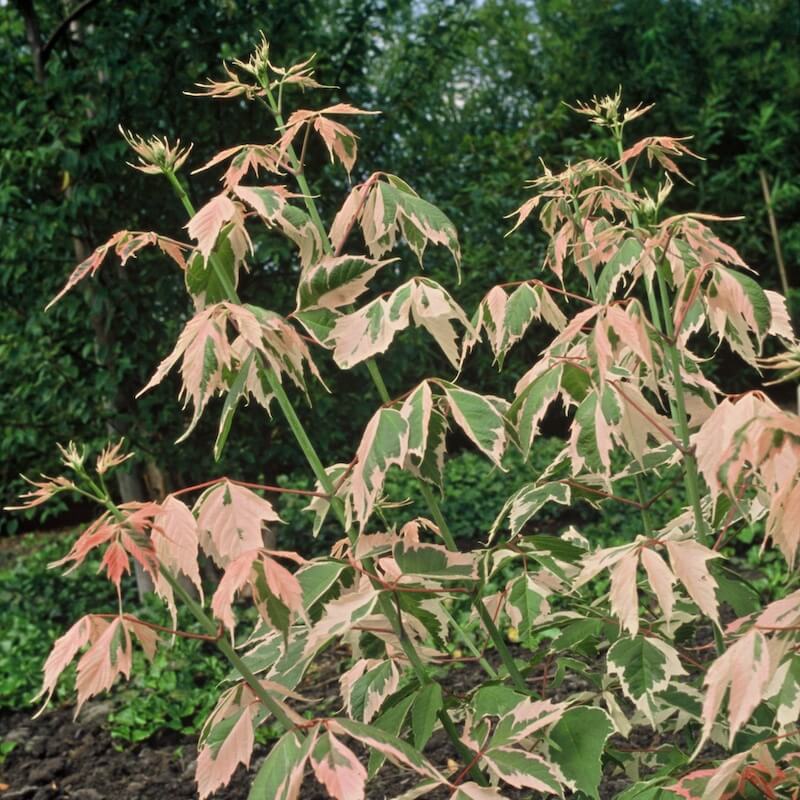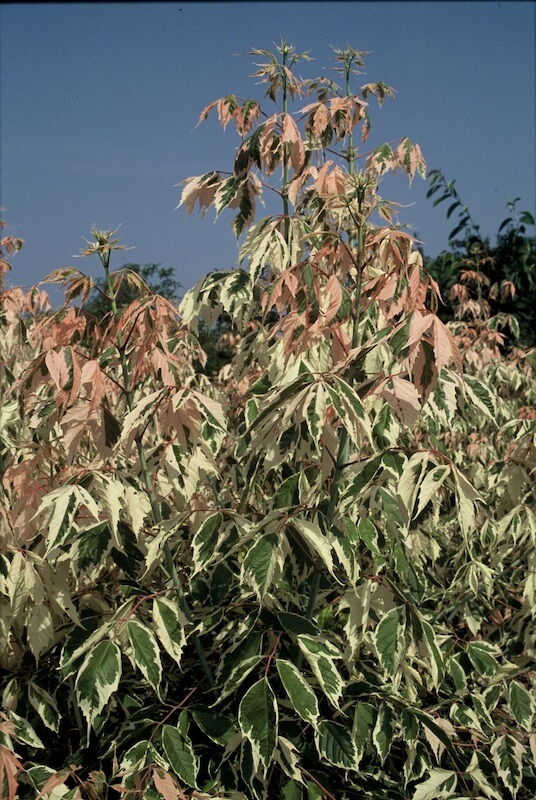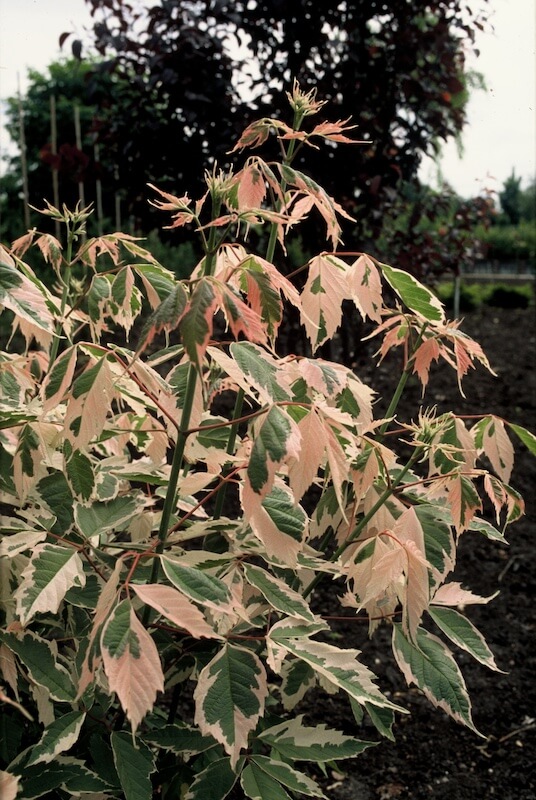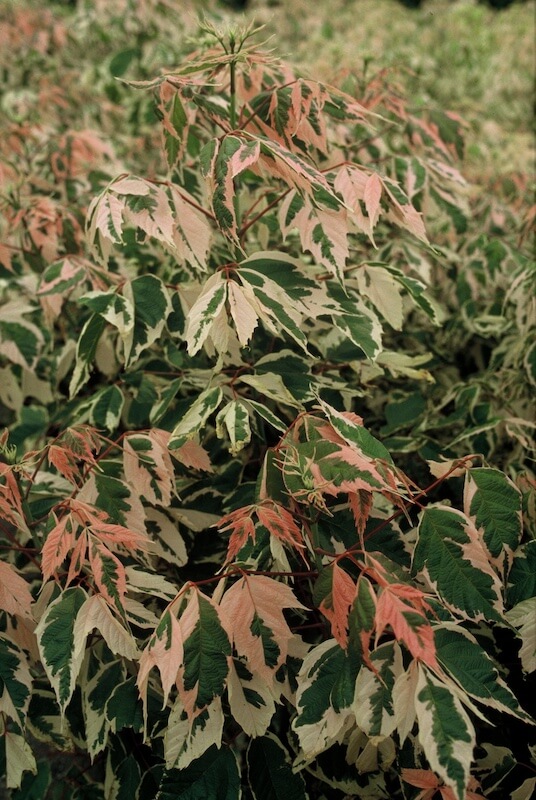Acer negundo Flamingo - A Splash of Pink for Your Garden
Box Elder Flamingo, Ashleaf Maple

Position
- Prefers full sun to light shade for best foliage colour
- Suitable as a specimen tree in lawns, spacious borders, or large gardens
- Sheltered from strong or salty winds for the best leaf quality
Hardiness
- Hardy to approximately –24°C (–11°F)
- Suitable for all regions of the UK, including colder inland and upland areas
Soil
- Tolerates a wide range of well-drained soils, including loam, sandy, or clay, if not waterlogged
- Benefits from soil improved with compost or well-rotted manure to retain moisture and promote health
- Does not thrive in areas where drainage is poor
- Will grow in acid, neutral, or alkaline soils
- Tolerant of most soil pH levels; tends to perform best in neutral to slightly alkaline soils
- Grab a soil test kit and ensure the perfect conditions for growth
Height
- Reaches 4–6 metres (13–20 feet) after 5–10 years
- Develops a broad, bushy crown and can be pruned to size
Seasons of Interest
Additional Notes
- Fast-growing and relatively low-maintenance once established
- Prune in late autumn or winter if shaping is needed, but avoid heavy pruning in spring to prevent bleeding
- Remove any plain green shoots to retain variegation
- Benefits from annual mulching with compost or leaf mould in spring to conserve moisture and feed the roots
- Ideal for larger gardens—may be too vigorous for smaller spaces or containers
- Drought-tolerant once established, but provide extra water in prolonged dry spells
Why Gardeners Love the Variegated Acer negundo Flamingo
If you’re searching for a striking tree that offers a fresh, uplifting look to your garden, Acer negundo Flamingo, also known as the variegated box elder or ashleaf maple, is a fantastic choice. This medium-sized, fast-growing tree features delightful variegated foliage, boasting pale pink margins and creamy-white splashes on fresh green leaves.
What Is Acer negundo Flamingo and Why Choose It for Your Garden?
Acer negundo Flamingo is a variegated form of the box elder, a species of maple tree native to North America. Unlike many other maples, this one stands out thanks to its soft pinnate leaves, rather than the more typical lobed shape. The foliage emerges green with white and matures with gentle pink variegation, particularly vivid in spring and summer.
This deciduous tree is typically grown as a large shrub or small tree, depending on the pruning method chosen. The overall effect is light, airy, and bright, making it ideal for lifting darker planting schemes or contrasting with deeper foliage tones.
Gardeners love it for its soft colours, fast growth, and low-maintenance nature. If you want to brighten a dull corner or add charm to a shrub border, this could be the perfect plant.
How Tall Does the Variegated Box Elder Grow?
Expect Acer negundo Flamingo to reach up to 6m in height and spread around 4–6m in width at maturity. Its relatively quick growth makes it excellent for gardeners wanting fast impact.
If you have limited space or prefer a tidier shape, the tree can be pruned back to maintain a smaller, more compact form. It’s particularly effective when trained as a multi-stem specimen or kept smaller and bushier through regular light pruning.
With its soft, airy canopy and ornamental appeal, it adds height without overpowering neighbouring plants.
Where Should I Plant Acer negundo Flamingo?
Select a position in full sun or partial shade for optimal results. The pink variegation is most vibrant when exposed to plenty of natural light.
The plant prefers well-drained soil, although it will tolerate a range of types, from loam to chalk. Avoid heavy clay soils, as these can cause problems during wet winters. If you’re unsure about drainage, consider improving the area with organic matter or raising the planting height slightly.
It’s best suited to a sheltered garden spot, away from strong winds, which can scorch the leaves and spoil the variegation effect.

What Kind of Soil Does This Maple Tree Prefer?
Acer negundo Flamingo thrives in fertile, moist, but well-drained soil. Although tolerant of different conditions, it performs best in neutral to slightly alkaline soil.
If your garden soil is poor or compacted, incorporate compost or well-rotted manure to improve its structure and nutrient content. Avoid letting the soil dry out completely during hot weather, especially in the first year after planting.
Remember, better soil means a happier, healthier plant, and you’ll be rewarded with more vibrant foliage.
How Do I Prune Acer negundo Flamingo?
Pruning this tree is straightforward and usually done to control size or shape. The best time to prune is in late winter or early spring before the leaves emerge.
You can also lightly prune in midsummer to encourage fresh growth and improve variegation. Avoid hard pruning after late summer, as this can encourage soft growth that’s vulnerable to frost.
For a more shrubby form, cut the stem low to promote bushier regrowth. If you prefer a standard or small tree, prune the lower branches and allow the main trunk to develop.
What Does the Foliage Look Like Throughout the Year?
The foliage of Acer negundo Flamingo is its standout feature. The young leaves emerge a soft green with white, quickly developing that characteristic white and pink variegation.
The pale pink tones are strongest in early spring and summer, giving the tree its distinctive, fresh look. By autumn, the colours may fade, but you’ll still enjoy an attractive light canopy before leaf fall.
With a backdrop of richer green leaves and flowering plants, this maple provides welcome contrast and seasonal interest.
How Hardy Is Acer negundo Flamingo in the UK?
This tree is considered fully hardy across most of the UK, tolerating temperatures as low as around -24°C (-11°F). Once established, it copes well with cold winters and brief periods of frost.
However, as with many variegated trees, the leaves can be more prone to damage from cold winds or spring frosts. Shelter the plant from harsh exposure, especially in more northern regions or coastal gardens.
Young trees may benefit from a protective mulch or fleece wrap during their first winter to improve their overall hardiness.

Can Acer negundo Flamingo Be Grown in Containers?
Yes, you can grow this tree in a large container, particularly if you want to enjoy its colourful foliage on a patio or terrace. Select a deep pot with good drainage holes and use a loam-based compost, such as John Innes No. 3.
Water the soil regularly to keep it moist, especially during dry spells. Feed with a balanced liquid fertiliser in spring and again in midsummer to support healthy leaf growth.
Container-grown trees will remain smaller, making them ideal for smaller gardens or courtyard spaces.
Where Can I Buy Acer negundo Flamingo in the UK?
You’ll find Acer negundo Flamingo at most reputable nurseries and online garden centres. When selecting a plant, look for healthy foliage, a sturdy central stem, and evidence of vigorous growth.
Nurseries often stock this variety as a grafted plant, which ensures consistent variegation. You can also find multi-stem or standard forms depending on your garden design.
Spring and early autumn are the best times to buy and plant, giving the tree time to settle in before the growing season or winter chill.
What Makes Acer negundo Flamingo a Great Choice for Seasonal Colour?
If you’re looking to add soft contrast to darker plantings, the white or pale pink variegation of this tree offers a light, refreshing feel. It works beautifully as a focal point in mixed borders or as a statement near a seating area.
Its delicate, variegated leaves complement ornamental grasses, purple-leaved shrubs, or deep green plants. Try combining it with underplanting of lavender, salvia, or ferns for layers of colour and texture.
The changing tones through spring and summer, followed by gentle autumn fade, make it a valuable feature in a seasonal planting scheme.
Is Acer negundo Flamingo Right for Your Garden?
If you want a fast-growing, low-maintenance tree with soft, light-reflecting colours, Acer negundo Flamingo is well worth considering. It suits both traditional and modern gardens, offering excellent value as a feature plant.
Its manageable size and good tolerance of different soils and conditions make it a flexible choice for many situations. Whether grown as a small tree, a large shrub, or a pot specimen, it brings personality and charm.
By providing good soil, occasional pruning, and protection from strong winds, you’ll enjoy years of graceful colour and structure.
From Darren’s Patch
I added Acer negundo Flamingo to my garden a few years ago to brighten a tired border, and I haven’t looked back. Its variegated foliage brings just the right amount of lightness, and it’s remarkably undemanding. I give it a light prune in early spring, and it responds with healthy new growth and even better colour. It’s one of those plants that makes you look like a better gardener than you are—it performs reliably, looks good for months, and plays well with others.
![]()
Key Points to Remember
- A variegated box elder with soft green leaves and white and pink variegation
- Medium-sized, fast-growing tree reaching up to 6m in height
- Best planted in full sun or light shade in well-drained soil
- Keep away from strong winds to prevent leaf scorch
- Hardy to around -24°C (-11°F), but shelter young plants
- Easy to prune to maintain shape or grow as a large shrub
- Ideal for borders, container planting, and seasonal displays
- Attractive foliage adds colour from spring to autumn
- Available from specialist nurseries and online retailers
- A beautiful and rewarding tree for UK gardens
Acer negundo Flamingo flourishes in full sun to light shade, tolerates a wide range of improved, well-drained soils, and is hardy to –24°C (–11°F). Reaching 4–6 metres (13–20 feet) in 5–10 years, it offers eye-catching variegated and pink-tinged foliage from spring well into autumn, with understated flowers in early spring. This robust, fast-growing tree is easy to care for, with most of its needs met through annual improvement and light pruning.
Want to learn about other shrub varieties? Read about Acer palmatum Seiryu here.
For more information on Shrubs for your garden, please click here.

Frequently Asked Questions
Q: What is Acer negundo Flamingo, and why is it also called the variegated box elder?
A: Acer negundo Flamingo, also known as the variegated box elder or ashleaf maple, is a fast-growing, medium-sized deciduous tree prized for its distinctive pink and white variegated foliage. Unlike most maples, it has pinnate leaves that resemble those of an ash tree. In spring and summer, the young leaves emerge green with pale pink and creamy-white margins, gradually maturing to soft green with white variegation. This ornamental tree brings a playful splash of colour to borders or lawn settings and is often grown as a specimen or large shrub in both contemporary and traditional UK gardens.
Q: Where can I buy Acer negundo Flamingo in the UK?
A: Acer negundo Flamingo is readily available from specialist tree nurseries, well-stocked garden centres, and reputable online plant retailers across the UK. When purchasing, look for healthy young trees with good variegation and a well-formed structure. Many nurseries offer this maple either container-grown or as bare-root stock in autumn and early spring. It’s ideal to plant during the dormant season to encourage successful establishment. Due to its ornamental value and ease of care, this tree is popular with both home gardeners and landscape designers seeking variegated trees that add light and seasonal interest to the garden.
Q: What are the ideal growing conditions for Acer negundo Flamingo?
A: Acer negundo Flamingo thrives in fertile, well-drained soil and benefits from a sunny or lightly shaded position. While tolerant of a range of soil types—including clay—it dislikes prolonged waterlogging. The variegated foliage can be sensitive to intense sunlight and strong winds, which may cause the leaves to scorch. Therefore, choose a sheltered site where the tree can enjoy morning sun or dappled light. Keep the soil moist during dry spells, particularly in the first few years after planting. An annual feed in early spring, combined with a mulch of organic matter, will help retain moisture and enhance overall plant health.
Q: How large does Acer negundo Flamingo grow, and can it be pruned?
A: Typically reaching around 4–6 metres in height with a broad, spreading shape, Acer negundo Flamingo can be grown either as a small tree or a large, multi-stemmed shrub. Its fast-growing nature makes it suitable for creating structure and seasonal interest relatively quickly. Pruning can be carried out in late winter or early spring before growth resumes. You can prune to maintain shape, remove crossing stems, or rejuvenate the tree if it becomes leggy and overgrown. Some gardeners choose to prune back hard every few years to encourage fresh, vibrantly variegated young leaves, resulting in more striking spring and summer colour.
Q: What makes the foliage of Acer negundo Flamingo so attractive?
A: The foliage of Acer negundo Flamingo is its main ornamental feature. The pinnate leaves are initially tinged with pale pink and white on the margins, fading to green with creamy variegation as the season progresses. This white and pink variegation gives the tree a bright, airy quality, especially effective when set against darker planting schemes. The tree’s fresh spring and summer tones offer lightness and contrast in the garden, while in autumn the leaves may develop soft yellow hues. Its distinctively shaped foliage, unusual for a maple, makes this tree a striking choice for seasonal and year-round interest.
Q: Is Acer negundo Flamingo hardy in the UK, and how does it cope with winter?
A: Yes, Acer negundo Flamingo is fully hardy throughout most of the UK, withstanding winter temperatures without difficulty. As a deciduous tree, it will drop its leaves in autumn and enter dormancy over the colder months. The bark and structural form can still offer interest during winter, although it is primarily prized for its colourful foliage during the growing season. In exposed or particularly cold regions, a sheltered position is advisable to protect young shoots from wind damage. A winter mulch can help insulate roots in colder climates, especially in the first few seasons after planting.
Q: Can Acer negundo Flamingo be grown in smaller gardens or containers?
A: While Acer negundo Flamingo is fast-growing, it can be suitable for smaller gardens if managed with regular pruning. Its soft, airy canopy and colourful variegated leaves make it a lovely ornamental feature in compact spaces. When grown in containers, select a deep, sturdy pot and use a loam-based compost such as John Innes No. 3. Ensure good drainage and position the container where the tree receives ample light without excessive exposure to midday sun. Container-grown specimens require more frequent watering and an annual feed to sustain healthy growth and vibrant variegation. Regular pruning helps to maintain a manageable size.
